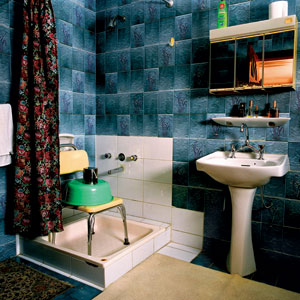My Father’s House: The Architecture of Cultural Heritage
Sharjah Museum of Islamic Civilization
Sharjah, United Arab Emirates
December 6, 2009–January 23, 2010
Originally printed in the March/April 2010 issue of Afterimage
 While some welcome the rapid “modernization” within the Persian Gulf region, others are apprehensive—concerned that it will wipe away the very essence of what has made this area unique. “My Father’s House: The Architecture of Cultural Heritage” attempts to grapple with this culturally significant time within the broader Middle East, which has raised debate in regard to notions of identity, tradition, and authenticity. Conservative in approach, this exhibition offers an interesting look at how architecture reflects and envelops the notion of identity within both physical and social realms. From Tim Hetherington’s images of the banal to Boushra Almutawakel’s series of home interiors entitled “Strata” (2007), this exhibition, sponsored by the British Council, features eight lens-based artists (five from the Middle East and three from the United Kingdom) that impart different approaches to understanding the complex nature of the Middle East through their interactions with the region’s architecture and the people who inhabit it.
While some welcome the rapid “modernization” within the Persian Gulf region, others are apprehensive—concerned that it will wipe away the very essence of what has made this area unique. “My Father’s House: The Architecture of Cultural Heritage” attempts to grapple with this culturally significant time within the broader Middle East, which has raised debate in regard to notions of identity, tradition, and authenticity. Conservative in approach, this exhibition offers an interesting look at how architecture reflects and envelops the notion of identity within both physical and social realms. From Tim Hetherington’s images of the banal to Boushra Almutawakel’s series of home interiors entitled “Strata” (2007), this exhibition, sponsored by the British Council, features eight lens-based artists (five from the Middle East and three from the United Kingdom) that impart different approaches to understanding the complex nature of the Middle East through their interactions with the region’s architecture and the people who inhabit it.
At the entrance to the exhibition, photographer Tim Loveless set the stage for the show with his series of architectural photographs “Reconstructed Histories” (2007–08), which document historically significant buildings as well as the “modernization” of older, dilapidated structures outfitted with electricity and air conditioners. Nestled among these photographs is an image that is key to understanding the thesis of the show—a photo of a bird’s-eye view atop Abu Dhabi’s elder fortress, Qasr Al Hosn. Overlooking a skyscraper-filled landscape, it embodies a complex tension between tradition and modernization.
Lamya Gargash’s subtle yet visually rich series of photographs, “Presence” (2007), depicts vacant rooms that exude a sense of loneliness, isolation, and transience. The carefully composed images portray interiors that range from the deteriorated and dilapidated to the opulent, and have one thing in common: the inhabitants of these dwellings are all in a state of transition—they have either moved out or are in the process of leaving these dwellings for newer and more contemporary conveniences. This sparks an intriguing metaphor about the rapidly shifting population and socio-economic makeup of the Emirates, as some search for a seemingly “better” and more “modern” way of life.
Hazel Thompson’s five-channel video installation, “Measure of a Woman” (2007), examines the daily lives of Muslim women from different generations living in Qatar and Bahrain. Combining text, sound, and still imagery within a time-based environment, this bilingual piece, in both Arabic and English, presents an intriguing intergenerational portrait of women living in these respective countries. The piece portrays the women as proud, strong, and determined. Thompson writes, “The women I met in the region are far more active in their community than I had expected, and their roles are far from exclusively confined to the home.”1
Sean Williams, curator of the exhibition, stated in an email interview with this author, that the title of the exhibition, “My Father’s House,” is “supposed to reference history and tradition whilst also questioning [the] general notion that all social constructs were shaped exclusively by men.”2
“Once Upon a Time” (2007), Wed Abdul-Jawad’s low-tech installation using pinhole camera photography, a slide projector, and audio interviews, alludes to Jeddah’s oral traditions and functions nicely given the show’s thematic intent. Nevertheless, Hafiz Ali’s narrative documentary Scent of Shadows (2008), which elucidates the history of early cinema in Qatar, appears out of place within the context of the exhibition, as other works have a more intimate and subjective nature. With Ali’s command of the documentary form, it might have been more effective to respond with a personal story closer to the theme of the show.
Camille Zakharia’s photo installation, “Al Bilad (Oman)” (2007), is a collection of photographs organized on a grid-like structure with a central vein. As the viewer follows the main strand downward, a path-like sequence unfolds, beginning with the mountains and ending with the sea, with water as a focal point for much of the imagery. Offshoots of blocks of photos from this central spine include images of architecture and everyday life. A sharp contrast from the massive building projects in the region, this gentle installation offers relief as it presents a simpler, more intimate way of life.
“My Father’s House: The Architecture of Cultural Heritage” began with a seemingly straightforward premise. However, the work in the exhibition reveals that there is a much more complex interplay between the social and physical realms, which helps define who we are and reminds us that identities are not fixed but rather changing and shifting.
NOTES 1. Hazel Thompson, Artist Statement, My Father’s House: The Architecture of Cultural Heritage (London, England: British Council, 2009). 2. Author interview via email with Sean Williams on January 5, 2010.